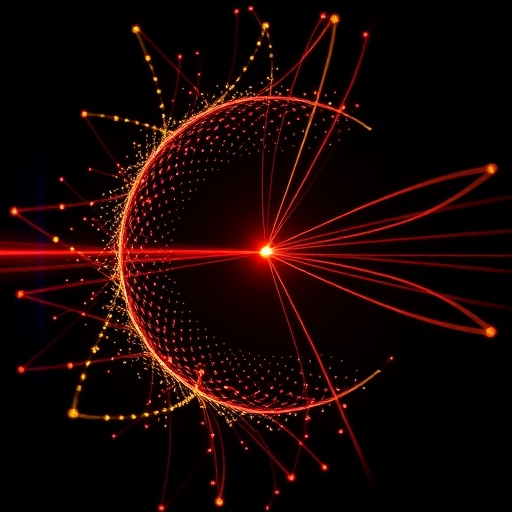In a groundbreaking advancement poised to redefine our understanding of light-matter interactions, researchers J.W. Ryu and K.D. Park have unveiled a revolutionary nanoscale ultrafast camera capable of capturing the intricate dance of photons and electrons in real time and three-dimensional space. Published in the prestigious journal Light: Science & Applications, this pioneering technology overcomes long-standing challenges in ultrafast imaging by harmonizing unprecedented temporal and spatial resolutions, opening new frontiers in physics, material science, and photonics.
The interaction between light and matter underpins countless natural phenomena and technological applications—from the energy conversion processes in photovoltaic devices to the signaling pathways within biological cells. However, deciphering the ultrafast dynamics that govern these interactions has traditionally been hampered by limitations in imaging technologies. Conventional methods often trade off spatial resolution for temporal speed or vice versa, leaving researchers with fragmented insights. Breaking this impasse, the innovative nanoscale ultrafast camera fabricated by Ryu and Park achieves a delicate balance, enabling snapshot capture of light-induced phenomena occurring on femtosecond timescales (one quadrillionth of a second) and nanoscale spatial domains.
At the heart of this technical marvel lies a sophisticated integration of ultrafast pulsed laser systems with cutting-edge nanophotonic architectures. By harnessing exquisitely timed excitation pulses synchronized with a highly sensitive detection mechanism, the camera reconstructs the spatial distribution of transient electromagnetic fields as they evolve. The researchers implemented an advanced pump-probe configuration, where a pump pulse initiates the light-matter interaction and a precisely delayed probe pulse images the resulting dynamics. This approach, combined with novel plasmonic enhancement techniques, elevates resolution beyond diffraction limits, granting unprecedented visualization of electron oscillations and energy transfers at the nanoscale.
.adsslot_R9LpOHrcnd{ width:728px !important; height:90px !important; }
@media (max-width:1199px) { .adsslot_R9LpOHrcnd{ width:468px !important; height:60px !important; } }
@media (max-width:767px) { .adsslot_R9LpOHrcnd{ width:320px !important; height:50px !important; } }
ADVERTISEMENT
This capability transcends traditional imaging modalities by rendering a vivid depiction of temporal evolution and spatial heterogeneity in a single experiment. For example, the technology can resolve how energy migrates through nanostructured materials or track the excitation and relaxation pathways in quantum dots with exquisite fidelity. The implications for material design are profound; researchers can now empirically observe how modifications in nanostructure geometry influence ultrafast optical responses, enabling a feedback loop that accelerates the engineering of highly efficient optoelectronic devices.
Moreover, the nanoscale ultrafast camera offers transformative potential for the burgeoning field of quantum photonics. Here, controlling and understanding light-matter coupling at ultrashort timescales is crucial for developing qubits and coherent information processing systems. The camera’s ability to directly visualize photon-electron interactions with nanoscale precision provides an indispensable investigative tool to refine quantum architectures, optimize coherence times, and mitigate decoherence pathways, pushing quantum technologies closer to practical realization.
Beyond physics and engineering, this technology also holds promise for biological research. Ultrafast processes, such as photosynthesis or light-activated signaling in cells, unfold at spatiotemporal scales that conventional microscopy struggles to probe. With its nanoscale resolution and femtosecond temporal gate, the ultrafast camera can elucidate fundamental mechanisms by capturing transient intermediate states in biomolecules during photoactivation, shedding light on complex biochemical pathways with unprecedented clarity.
Significantly, the development of this imaging platform required addressing several formidable challenges. One of the key hurdles was maintaining optical stability and minimizing noise in the detection system to reliably capture fleeting signals buried within background fluctuations. Ryu and Park overcame these obstacles through meticulous engineering of ultralow-noise amplification schemes and real-time data processing algorithms that extract meaningful information from massive datasets rapidly. Their approach leverages machine learning frameworks trained to identify and reconstruct subtle dynamical signatures, thereby enhancing both sensitivity and speed.
From a fundamental physics standpoint, the nanoscale ultrafast camera facilitates explorations into light-induced phenomena that have so far been inaccessible. For instance, it enables direct observation of plasmonic field propagation, nonlinear optical effects, and ultrafast phase transitions at nanometer dimensions. This capacity to image transient states in real space offers a window into emergent phenomena such as exciton-polariton condensation or coherent phonon generation, deepening our grasp of condensed matter physics and guiding theory development.
Furthermore, this innovation dovetails with recent advances in nanofabrication and computational imaging methods. The camera’s design incorporates metamaterial lenses and adaptive optics tailored to optimize focus and mitigate aberrations at ultrashort exposure times. Its compatibility with versatile sample environments—ranging from vacuum chambers to biological fluids—broadens its applicability across disciplines. As a modular platform, it can integrate with complementary instruments such as electron microscopes or spectrometers, facilitating correlative multi-modal analyses.
The researchers underscore that their nanoscale ultrafast imaging paradigm represents more than a technological feat; it is a conceptual leap towards capturing the fundamental dynamics that define the behavior of light-matter systems. By bridging time and space scales seamlessly, the camera serves as a “time microscope” revealing processes that were once considered too rapid and small to observe directly. This capability promises to accelerate innovation in energy harvesting, data processing, medical diagnostics, and beyond, as insights gleaned from experimental data inform the rational design of next-generation materials and devices.
Looking ahead, further refinement of this technology could amplify its impact. Strategies under consideration include extending spectral coverage to infrared and ultraviolet regimes, enhancing temporal resolution towards attosecond domains, and miniaturizing components to create portable ultrafast imaging devices. Additionally, coupling the camera with real-time feedback systems could enable active control of dynamic processes, opening avenues in adaptive photonics and smart material systems.
In summary, the work by Ryu and Park introduces a powerful tool that captures the fleeting interplay between light and matter with extraordinary precision. By marrying ultrafast temporal gating with nanoscale spatial discrimination, their nanoscale ultrafast camera unlocks new vistas for scientific exploration and technological innovation. As the device makes its way into laboratories worldwide, it is poised to catalyze discoveries across physics, chemistry, biology, and engineering, illuminating the hidden dynamics that govern our universe one frame at a time.
Subject of Research: Ultrafast imaging of light-matter interactions at the nanoscale
Article Title: Nanoscale ultrafast camera unveils light-matter dynamics in real time and space
Article References:
Ryu, J.W., Park, KD. Nanoscale ultrafast camera unveils light-matter dynamics in real time and space. Light Sci Appl 14, 221 (2025). https://doi.org/10.1038/s41377-025-01908-9
Image Credits: AI Generated
Tags: advanced photonics technologyapplications in material sciencebreakthrough in ultrafast camerasfemtosecond temporal resolutioninnovations in energy conversionlight-matter interaction studiesnanoscale spatial imagingphoton-electron interactionsreal-time light dynamicssynchronization of laser systemsultrafast imaging challengesultrafast nanoscale imaging






